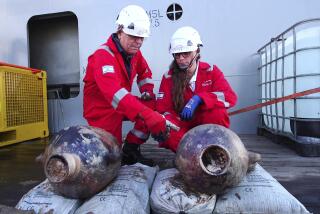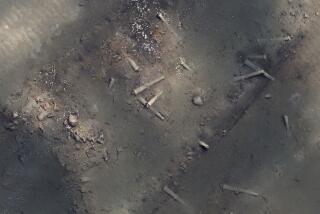Ancient Greek jar is found off Albania’s coast
- Share via
saranda, albania -- Encrusted with tiny shells and smelling strongly of the sea, a 2,400-year-old Greek jar lies in a saltwater bath in Durres Museum, on Albania’s Adriatic coast.
Part of a sunken shipment of as many as 60 ceramic vessels, the 26-inch storage jar, or amphora, was the top find from what organizers say is the first archaeological survey of this small Balkan nation’s seabed, conducted by U.S. and Albanian experts.
“Touch it, touch it. It’s luck,” said mission leader George Robb of the Key West, Fla.-based RPM Nautical Foundation. “You’re touching something that was made before Plato was born.”
Launched in July, the monthlong survey was the first step in compiling an underwater cultural heritage map that could eventually plot the positions of sunken fleets from ancient and medieval times believed to lie along Albania’s 220-mile coastline.
Auron Tare, the project’s local coordinator, said Albanian authorities were hoping to sign a deal with RPM, a nonprofit foundation, for a five-year survey.
“That would give a boost to a still nonexistent field of archaeological research in the country,” Tare said. “It would be a great promotion for local tourism, especially diving tourism, and could possibly lead to the creation of an underwater archaeology museum.”
Archaeologist Adrian Anastasi said the survey would help protect the country’s marine cultural heritage from looters -- an increasing problem since the collapse of the country’s hard-line communist regime in 1990.
The survey “will help create the necessary legal and structural infrastructure to protect shipwrecks from looting,” said Anastasi, Albania’s only archaeologist specializing in underwater research.
Anastasi said the project, using up-to-date scanning technology, probably would have cost Albania $4.7 million to $5.4 million if it did it alone. “RPM has all the necessary modern technology, and is doing it with its own funding,” he said.
Linking the western Balkans and the East with western Europe, Albanian waters were busy with shipping during ancient and medieval times.
“In those times ships usually stayed near the shore, to maintain visual contact with land, and all our coastline was a very intensive route for commercial and other traffic,” Anastasi said.
The light-brown clay amphora, probably used to store wine or oil, was found on the last day of the survey off the ancient town of Butrinti near Saranda, about 186 miles from Tirana and opposite the Greek island of Corfu. It dates to the 4th century B.C.
The find will stay immersed in water at the museum in Durres, 20 miles west of Tirana. Museum workers will gradually reduce the water’s salinity over the next year, to remove salt from the amphora ahead of its conservation.
“Based on what we can see on the surface, there is a high probability that [the amphora] is a sign of a shipwreck located deep there from that period,” said Jeffrey G. Royal, archaeological director of RPM, whose Mediterranean operations are based in Valletta, Malta.
If so, it would be the first 4th century B.C. wreck to be located in Albanian waters, say survey organizers, who are keeping the find’s precise location and depth secret for fear of looting. Only a few wrecks from that period have been excavated in the Mediterranean.
Anastasi said 50 to 60 amphorae were located on the seabed. Once the finds are assessed, an effort will be made to uncover the wreck, which would give information on the ship’s destination and naval architecture of the period.
Albanian officials also plan to ask permission from neighboring Montenegro for the RPM’s Hercules research vessel to continue its exploration north of Albania.
The ship also located 14 other shipwrecks from the 19th and early 20th centuries, in the survey that ended Aug. 13.
More to Read
Sign up for Essential California
The most important California stories and recommendations in your inbox every morning.
You may occasionally receive promotional content from the Los Angeles Times.










